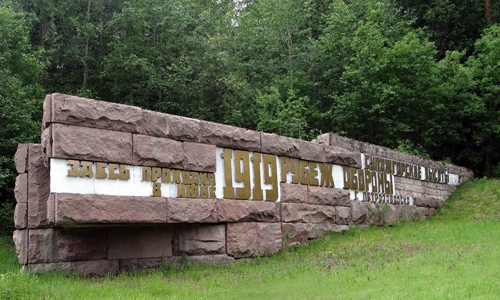Petrozavodsk defensive line
In the north-western part of modern Petrozavodsk, at the foot of the northern slope of the Sulazhgora Heights, is located the Soviet memorial commemorating the episode of so-called Kinship Wars, that took place here in 1919. Kinship Wars was a series of armed conflicts with participation of Finnish volunteers in countries neighbouring Finland at 1918-1922, but Finland as a state did not officially took part in the hostilities: Many of the volunteers were inspired by helping to related Finno-Ugric peoples or by the idea of Greater Finland. All Finnish Army officers who took part in the Kinship Wars were retired from military service. Olonets expedition was the most large-scale event of the of Kinship wars. In total, 118 activists of the Jäger movement and a few thousands volunteers took part in the expedition. Officially Commander of the expedition was Jäger Lieutenant-Colonel Ero Gadolin, but in fact commanded Jäger Major Gunnar von Hertzen with the Chief of his Staff Jäger Captain Ragnar Nordström. The Olonets Volunteer Army crossed the border on April 21, 1919. The Olonets City was captured on April 23. On April 29, the northern group of volunteers (troops of Jäger Major Paavo Talvela and Jäger Lieutenant Lauri Maskula) captured Pryazha Village and on the same day the southern group (troops of Jäger Captains Urho Sihvonen and Kalle Hyppölä) reached the Svir River. The first phase of the offensive ended May 3, when captured Kotkozero and Matrosy Villages. Immediately after the liberation of the Olonets City, the Olonets Temporary Organizational Council (the Chairman – Master in Law Otto Åkesson) was established by Finns, whose first goal was a creation of local representative government. Initially was expected that will be formed the Directory, contains four members from the Olonets volosts, three from the Petrozavodsk volosts and two from the Povenets volosts. Meanwhile, the Red Army was able to redeploy the additional troops to Karelia and launched a counter-attack. On May 4, Bolsheviks broke into Olonets City and the bloody fights began. On May 7, Gunnar von Hertzen had managed to re-establish control over the Olonets City, but on May 13, it was finally left. The Olonets Volunteer Army, which was reinforced by the local Civil Guards, was reorganized: the southern group still May 11, became the 1st Regiment under the command of Gunnar von Hertzen and the northern group on May 22, became the 2nd Regiment, as commander of which was designated Paavo Talvela. Instead of Ero Gadolin, who left his post of commander on April 28, Jäger Colonel Aarne Sihvo was appointed on May 13. At the end of May the five-person Olonets Temporary Government, contains four members from the volosts of Olonets uezd and one from the Petrozavodsk uezd, was formed: At the instance of the new government, the Olonets Temporary Organizational Council, consists of Finnish citizens (from May 26, Pekka Supinen as the Chairman), continued its activities. On June 5-7, an Assembly of eight East-Karelian volosts representatives was held in Pogrankondushi Village. Assembly expressed its confidence in the Olonets Temporary Government. Also it proclaimed the separation of Olonets Karelia from Soviet Russia and the accession to Finland. A delegation was sent to Helsinki. Initially there are no Finns in the Olonets Temporary Government. However, in July, the Salmi-Karelian Jaakko Seise joined to government as Deputy Chairman. Petrozavodsk direction became the main and all the reserves of the Olonets Volunteer Army was sent to Paavo Talvela, which received in early June an order to offensive. On June 13, was liberated the Polovina Village and on the next day the Vidany Village. The attack to Petrozavodsk City began on June 20, and advanced units reached the Sulazhgora Heights on the same day. The city was already visible from here. On the next day the battle continued, but the defensive line was not be broken through. On June 22, the offensive was stopped. Paavo Talvela prepared a new attempt in the next few days, but on June 27, the Bolshevik's flotilla landed the troops in Vidlitsa, on the coast of Ladoga Lake, in the rear of Olonets Volunteer Army. As wrote later Paavo Talvela: “It was at this time, at the end of June, when the capture of Petrozavodsk was only a matter of few days, happen a Vidlitsa disaster.” To avoid encirclement, Paavo Talvela began on June 30, retreating back to the West. On August 10, the Olonets Temporary Government was merged with the Olonets Temporary Organizational Council and on the same day was evacuated to Finland. On August 28, Paavo Talvela was designated as commander of the Olonets Volunteer Army. The Olonets expedition ended on September 18, 1919. The losses of Finnish volunteers were 569 killed. Paavo Talvela returned to Eastern Karelia in December 1921 and fought in the Karelian forests until the defeat of the East Karelian Uprising. In 1923 in Finland was instituted the Olonets Commemorative Medal and in 1938 was instituted the Kinship Wars Commemorative Cross. On the October 1, 1941 Jäger Major-General Paavo Talvela's VI Corps entered to the Petrozavodsk from the South. Through the Sulazhgora Heights Petrozavodsk defensive line broke the Jäger Major-General Woldemar Hägglund's VII Corps. The capital of East-Karelia was ultimately conquered. In the 1960s on the Sulazhgora Heights was unveiled a small obelisk with the inscription: “In June 1919 here was the Petrozavodsk defensive line where White-Finnish troops were stopped and rejected.” At November 6, 1987, aside from the razed Sulazhgora Heights, on Pryazha Highway was unveiled a new memorial by architect N.Ovchinnikov and engineer E.Ovsyannikov. The inscription says: “In June 1919 the Petrozavodsk's Sulazhgora defensive line was here.” In the 1990s the copper letters of inscription were stolen and replaced to wooden. |